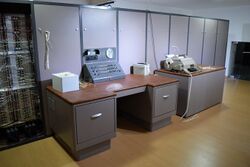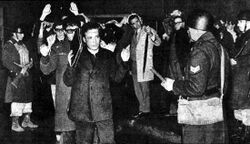Biography:Cecilia Berdichevsky
Cecilia Berdichevsky or Berdichevski (née Tuwjasz) (1925 – 2010) was a pioneering Argentinian computer scientist and began her work in 1961 using the first Ferranti Mercury computer in that country.[1]
Biography
She was born Mirjam Tuwjasz[2] on 30 March 1925 in Vidzy, at that time part of Poland, now Belarus.
Because of growing hostilities toward the Jewish community,[3] first her father and then her mother Hoda[2] and her emigrated to Argentina when she was four years old, where she adopted the name Cecilia, and she spent her childhood years in Avellaneda, south of the Buenos Aires suburbs. Her father died within a few years of arriving in their new home and her mother remarried a rich man.[3]
Cecilia married Mario Berdichevsky, a physician from Avellaneda, in 1951.[3]
Despite having a good job as a practicing accountant for ten years, she was not happy there having experienced many frustrations. A friend, computer scientist Rebeca Guber, convinced her to go back to school, which changed her life.[4]
Clementina
At the age of 31, Berdichevsky began her studies of mathematics at the University of Buenos Aires with Manuel Sadosky. There she had her first experience programming the new Ferranti Mercury computer, which became known by the nickname "Clementina" after someone programmed it to play the American song, "My darling Clementine."[5] In 1961, when it arrived in Buenos Aires from England, Clementina was the most powerful computer in the country, cost $300,000 and measured18 metres (59 ft) in length.[1] It was the first large computer used for scientific purposes in the country (in that same year, an IBM 1401 was installed in Buenos Aires for business uses).[4]
The newly graduated Berdichevsky studied computing from the visiting English software engineer Cicely Popplewell (famous for having worked with Alan Turing in Manchester) and with the Spanish mathematician Ernesto García Camarero.[3] Popplewell herself motivated Berdichevsky to write and run the first program for the new computer, which required multiple arithmetic calculations. A photoelectric device read a punched paper ribbon that was used to submit the data and Clementina produced the desired result in only seconds.[1][5]
Based on Berdichevsky's progress in Argentina, in 1962 she was one of two people[3] awarded scholarships to continue studies at the University of London's Computer Unit for five months, followed by the same length of time at a French institution.[1] She returned home the following year as an expert on the workings of Clementina. According to Berdichevsky,[1]
"Work with Mercury was defined by its resources and its characteristics, structure and operational capabilities, as well as by the languages, routines, stored libraries and facilities that it offered... Mercury could not perform more than one operation at the same time, and they were the three basic arithmetical operations: addition, subtraction, and multiplication."
The computer's resources included: machine language, an assembler named Pig2; a high-level programming language (a compiler) called Autocode. Later another compiler called Comic replaced Autocode.[1] In those days, compilers were unique and were written only for each computer; they were not developed for use on multiple models of computers until years later.[6]
In addition, Berdichevsky worked as Head of Practical Works of Numerical Calculus I, where the tenured professor was her mentor, Manuel Sadosky who was then vice-dean of the Faculty of Exact Sciences of the University of Buenos Aires from 1957 to 1966.[1]
Coup d'état
Berdichevsky worked with Sadosky's institute until an Argentinian coup d'état that installed a military dictatorship, which imposed government control over the workings of the previously autonomous state universities. This intrusion led to student/professor sit-ins that resulted in the violent Night of the Long Batons on 29 July 1966 when military troops physically beat and evicted the academic occupiers from the University of Buenos Aires and other institutions of higher learning. Many academics, including Sadosky, were forced into exile.[7]
Berdichevsky herself began working as an accountant. Between 1966 and 1970 she was also one of the directors of Scientific Technical Advisors (ACT), the company formed by her former academic associates, Manuel Sadosky, Rebeca Guber and Juan Chamero.[3]
Later years
In 1984, Berdichevsky became Deputy General Manager of the Argentine savings bank Caja de Ahorro in charge of its computer center. She was also named the representative at the International Federation for Information Processing.[3]
After her retirement, she continued to work as a computer consultant and participated in important international projects and organizations such as United Nations Development Program.[5]
Cecilia Berdichevsky died in Avellaneda, Argentina, 28 February 2010.[3]
Published work
- Berdichevsky C. (2006) The Beginning of Computer Science in Argentina — Clementina – (1961–1966). In: Impagliazzo J. (eds) History of Computing and Education 2 (HCE2). IFIP Advances in Information and Communication Technology, vol 215. Springer, New York, NY (complete paper in English)
References
- ↑ 1.0 1.1 1.2 1.3 1.4 1.5 1.6 Berdichevsky, Cecilia (2006). Impagliazzo, John. ed. "The Beginning of Computer Science in Argentina — Clementina – (1961–1966)" (in en). History of Computing and Education 2 (HCE2). IFIP Advances in Information and Communication Technology (New York, NY: Springer US) 215: 203–215. doi:10.1007/978-0-387-34741-7_15. ISBN 978-0-387-34741-7.
- ↑ 2.0 2.1 CEMLA immigration card: TUWJASZ/MIRJAM/4/Single/POLISH/WIDZE/1930/01/07/ASTURIAS/CHERBURGO.
- ↑ 3.0 3.1 3.2 3.3 3.4 3.5 3.6 3.7 Maruglobina (2019-09-23). "Women on Steam (Mujeres en STEAM: ¿Quién fue Cecilia Tuwjasz de Berdichevsky?)" (in es). https://medium.com/lasdesistemas/mujeres-en-steam-qui%C3%A9n-fue-cecilia-tuwjasz-de-berdichevsky-1705b4893a81.
- ↑ 4.0 4.1 devteam, educ ar. "Pioneras informáticas rioplatenses" (in es). https://www.educ.ar/recursos/132323/pioneras-informaticas-rioplatenses.
- ↑ 5.0 5.1 5.2 Abeledo, María Claudia (2017-03-08). "Cecilia Berdichevsky y Hedy Lamarr, legado femenino de la ciencia y la tecnología" (in es-ES). http://noticias.unsam.edu.ar/2017/03/08/cecilia-berdichevsky-y-hedy-lamarr-legado-femenino-de-la-ciencia-y-la-tecnologia/.
- ↑ Garcia Camarero, Ernesto (1961). AUTOCODE un sistema simplificado de codificacion para la computadora MERCURY (in Spanish). Universidad de Buenos Aires. p. 70.
- ↑ Morero, Sergio; Ariel Eidelman, Ariel; y Lichtman, Guido. La noche de los bastones largos, 2nd ed. Buenos Aires: Nuevohacer Grupo Editor Latinoamericana, 2002. Collection: Colección Temas. ISBN:950-694-684-1.





